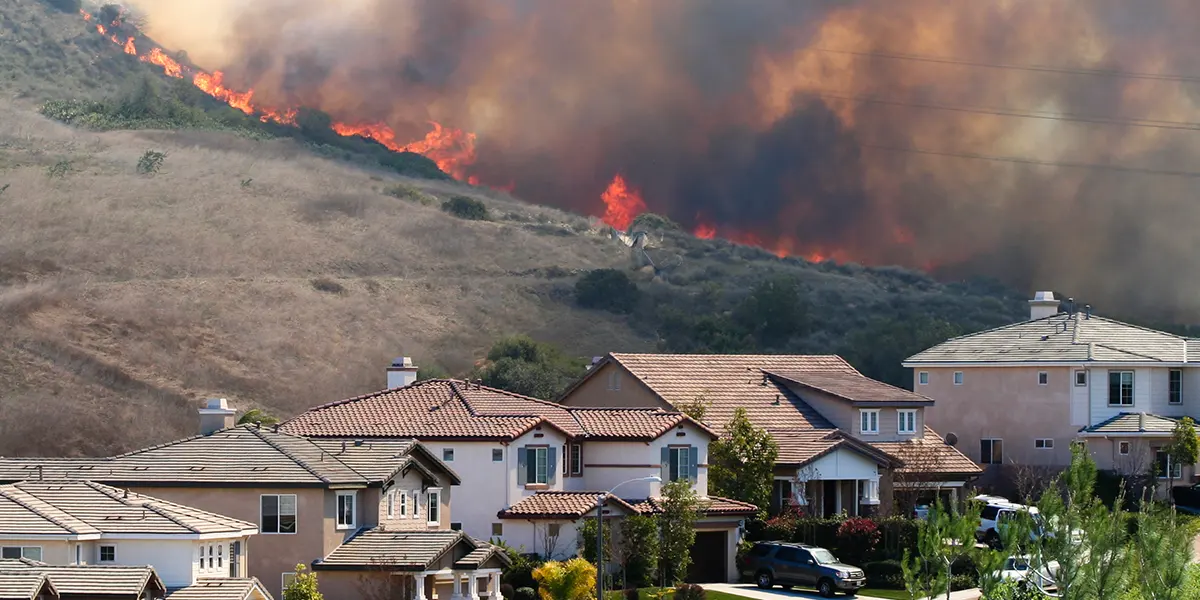Throughout July, global temperatures shattered records with the hottest day on 6th July, when the global average temperature reached 17.08°C (figure 1 below).
The UN secretary general, António Guterres, announced that “the era of global boiling has arrived”. This unprecedented heat highlights the alarming risks associated with rising temperatures worldwide. The profound consequences of extreme heatwaves include intensified wildfires, land subsidence, and droughts, imposing substantial economic burdens on industries unprepared for climate-related risks.
"This is not a milestone we should be celebrating", said climate scientist Friederike Otto of the Grantham Institute for Climate Change and the Environment at Britain's Imperial College London
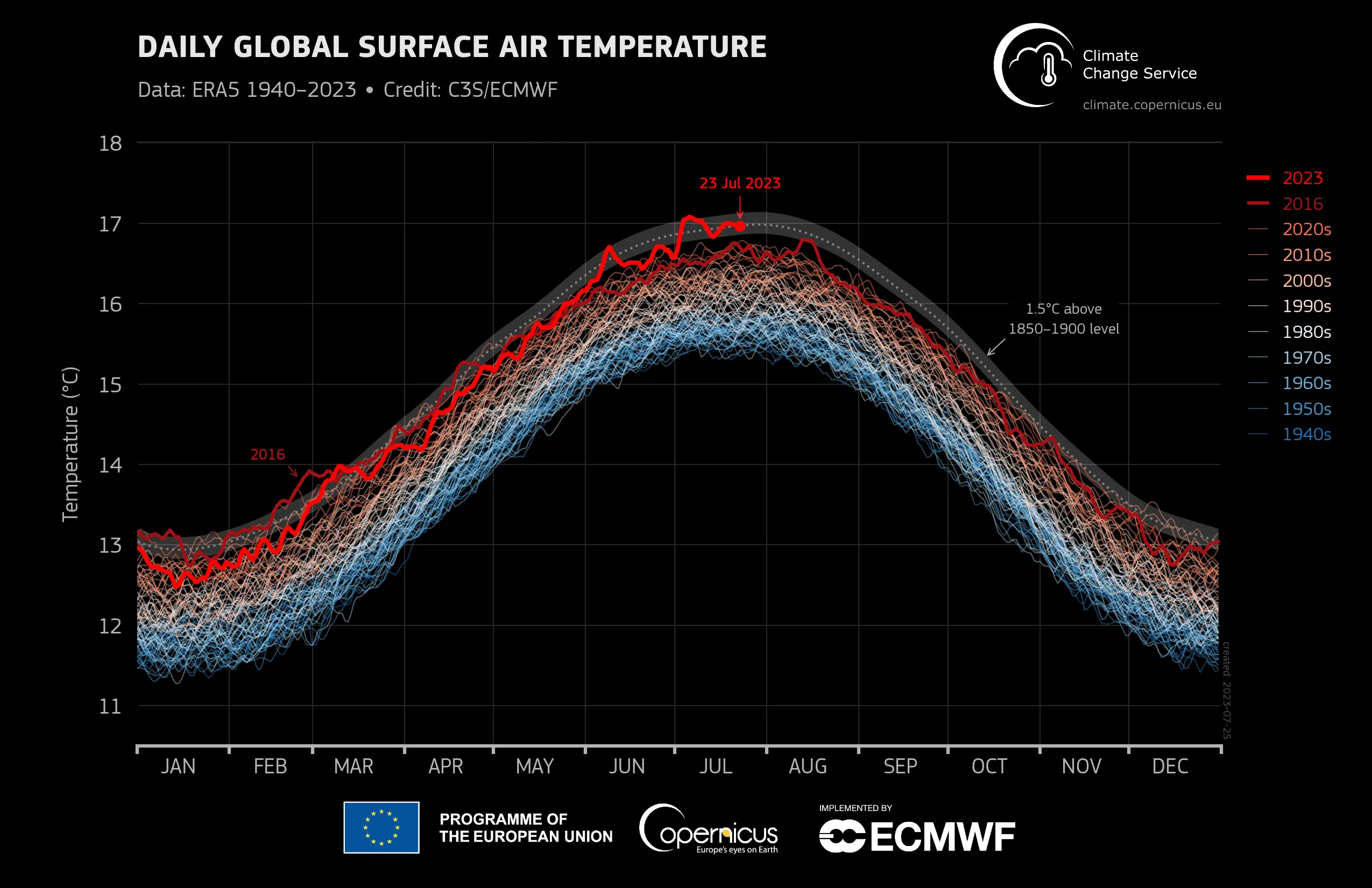
The Apocalypse of Canada
What looked like a Hollywood movie, images of an apocalyptic New York City sky turned orange from being strangled by smog captured the world's attention.
It was the implications of smoke from wildfires ravaging Canada, intoxicating the air quality of North America from the Midwest to the East Coast. And now, the wildfires induced by an early heatwave and droughts continue to burn, becoming the worst on record, affecting more than 100,000 people.
By the end of July, over 120,000 km2 had been burned, nearly twice as much as the previous record of 71,060 km2 burned in 1995. Almost equivalent to the size of Poland, and we’re only halfway through the wildfire season.
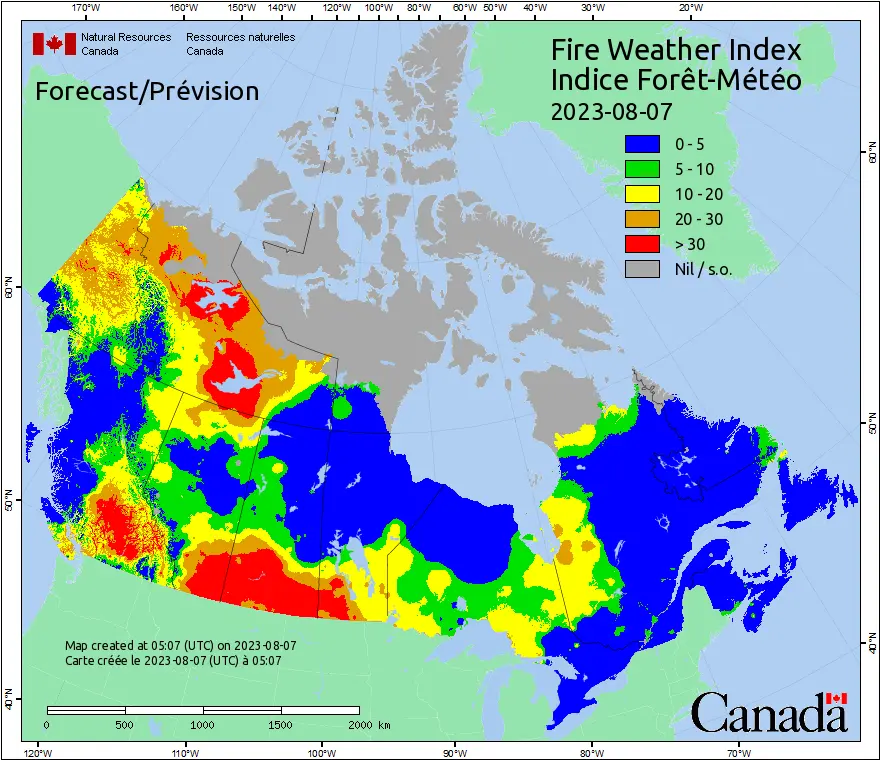
Dr Nicholas Leach, Climate Scientist at Climate X commented, "Climate change is affecting the frequency & intensity of heatwaves around the world, including the one experienced in Europe July this year.
"How climate change affects heat extremes is a combination of thermodynamic (broadly speaking, the overall global warming of the atmosphere) and dynamic (changes to the frequency and nature of the weather patterns that drive extremes such as heatwaves) processes.
"In Europe, the intensity of heat extremes are increasing much faster than both other similar regions around the world, and also faster than the “mean” temperature in Europe."
In Europe, the intensity of heat extremes are increasing much faster than both other similar regions around the world, and also faster than the “mean” temperature in Europe"
Dr. Nicholas Leach, Climate Scientist at Climate X
Canada's unprecedented wildfires affected air quality beyond its borders in U.S. cities, upending oil and gas operations, disrupting tourism, and dampening agriculture activities in regions of Quebec, Ontario, Alberta, and British Columbia, which have been suspended since mid-May.
In a worst-case scenario, the economic consequences could worsen if the wildfires spread from current rural areas to shut off major traffic corridors and cut off supply lines to large populated areas of the country.
Dave Sawyer, principal economist at the Canadian Climate Institute, claimed, "you couldn't model this out if you tried. We've always been concerned about this escalation of damages, but seeing it happen is so stark".
The current wildfires are estimated to significantly impact Canada's economic growth in the third quarter, with estimates ranging from 0.3 to 0.6 percentage point reduction.
This is attributed to the extensive destruction and disruption experienced across various industries, Figure 3. Furthermore, considering the increasing frequency and severity of climate-related risks in Canada, it has been projected that climate-related costs will reach CAD$25 billion by 2025.
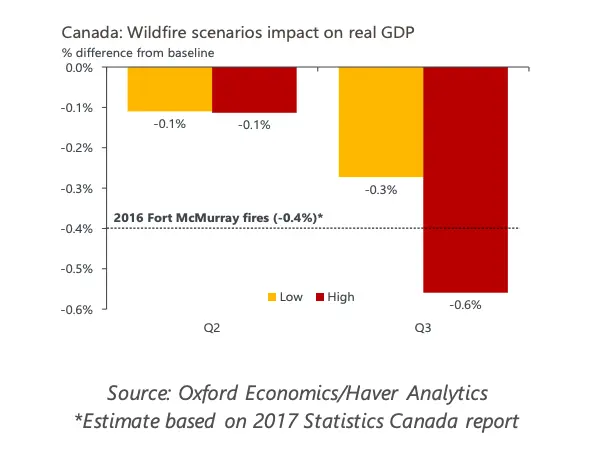
The insurance industry is alert, having watched the increasing damage in recent years with alarm. Before 2009, insured losses in Canada averaged around CAD$450 million annually, and now they routinely exceed $2 billion. Large reinsurers pulled back from the Canadian market after several crippling payouts, increasing prices for homeowners and businesses.
Low Levels: The Panama Canal
With 14,000 transits per year carrying roughly 270 million tonnes of cargo, the Panama Canal is the world's busiest and least expensive shipping trade route saving ships up to 8,000 nautical miles. The Canal is fed by rainwater from Panama's Gatun Lake. Still, a severe drought has induced water levels to fall to extremely low levels with implications on global shipping disruption experienced firsthand by the Ever Given ship becoming stuck in the Suez Canal in 2021 for six days invigorating $400 million worth of trade per hour.
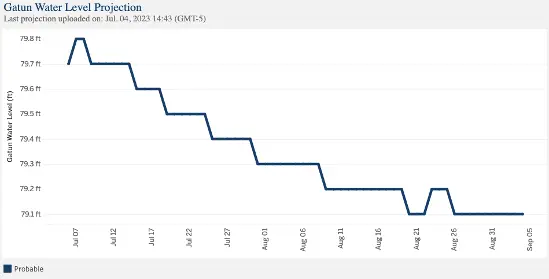
The declining water levels in the Panama Canal have had significant repercussions, compelling shipping vessels to reduce their cargo capacity.
This vital trade route between Asia and the U.S. East Coast has been adversely affected, resulting in fewer ships utilising the canal. Since the restrictions were implemented on June 25th, some ships have reduced their cargo volume by 40%.
Suppose the situation worsens and the water level in Gatun Lake continues to decline. In that case, the market will witness higher shipping rates and a frantic search by shipping carriers for faster alternative routes.
These alternate routes would involve direct voyages from Asia to the U.S. West Coast or the U.S. East Coast via the Suez Canal. However, rerouting cargo to the East Coast through the Suez Canal rather than the Panama Canal would add a week to the transit time, according to Peter Sand , the chief analyst at Xeneta in Copenhagen.
A journey from Shenzhen, China, to Miami, Florida, using the Suez Canal takes approximately 41 days for ocean cargo. Traversing the Panama Canal, although more costly, with fees potentially rising by up to 10%, can be completed in just 35 days. Continued drought conditions and the ongoing use of the Panama Canal will result in higher costs due to increased Panama Canal charges and reduced cargo loads.
Moreover, these challenges may have implications for trade redistribution. As much as 40% of all US container traffic, amounting to $270 billion annually, relies on the Panama Canal, particularly for trade with China, its largest partner.
Disruptions to this traffic will have profound negative consequences for US ports. While water level issues in the Panama Canal have persisted for several years, the worsening droughts are expected to exacerbate the situation at an alarming rate.
Important to note is that the progress of a new water management system initiated by the Panama Canal Authority to alleviate the concerns at Gatun Lake has been slow, with 250 project bid submissions still pending. Ultimately, the Panama Canal risks becoming a significant bottleneck and disrupting global trade.
Shipping companies will be compelled to reassess the efficiency of their operations to mitigate these challenges, which will likely result in narrower profit margins. Unfortunately, end consumers will also bear the impact through increased logistics costs.
A Two-Pronged Approach
In the face of escalating climate hazards, including monsoon floods and heatwaves, China and several other Asia-Pacific countries increasingly engage in a yearly summer showdown induced by climate change.
The region's summers, known for scorching heat and intense rainfall, have become increasingly severe. Average surface temperatures in the country have risen faster than the global average since the early 20th century.
Unprecedented heavy floods and early heatwaves have strained agricultural harvests, tested power grids, and threatened urban populations, displacing over 20,000 people in China.
The impact of extreme heat has been particularly felt in northern China. In June, Beijing experienced 13.2 days with temperatures exceeding 35°C, marking the highest number of super hot days for the month since record-keeping began in 1961. The mercury in thermometers even rose above 40°C.
Yet, concerns are mounting regarding a recurrence of last year's devastating drought, which was the most severe in 60 years. The drought affected 6.09 million hectares of crops at its peak, leading to billions of yuan in economic losses.
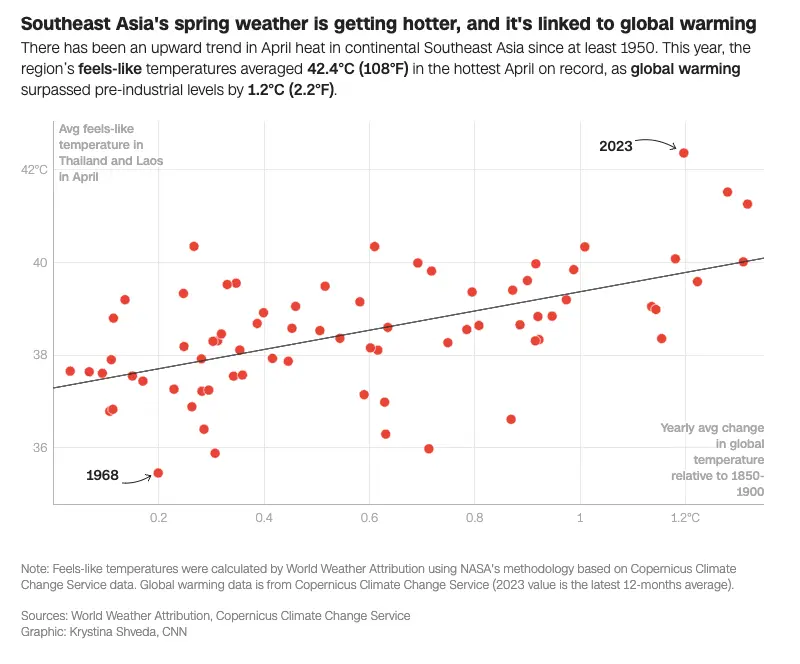
The disruption of the energy grid inflicts significant economic losses. Heatwaves intensify the demand for electricity as homes, malls, and offices require cooling, putting strain on the power supply and leading to potential blackouts.
Eastern China conducted its first-ever emergency drill in June to prepare for large-scale outages. Moreover, Yunnan, facing reduced hydropower output due to drought, implemented a 14% cut in its power-intensive electrolysis-based aluminium production in February.
To address the escalating flooding problem, Chinese officials unveiled plans to construct a megaproject consisting of a national network of canals, reservoirs, and storage facilities in May.
This initiative aims to unclog the river system and enhance control over water flows, reducing the risks associated with floods and droughts. Last year, the investment in fixed water assets surpassed 1.1 trillion yuan ($154 billion), marking a 44% increase compared to 2021.
In the first quarter of 2023, it rose by 15.6% to 407 billion yuan ($56 million), and officials assured that additional funding would be available. However, concerns persist that these projects will become more costly and environmentally disruptive over time, potentially rendering southern regions more susceptible to supply disruptions and necessitating further infrastructure development.
Ultimately, the alarming global climate events are a stark reminder of the urgent need for proactive measures and resilience-building efforts. It is imperative to detect and address climate risks early to mitigate the impact of climate change on organisations.
By proactively identifying and responding to these risks, greater resilience and adaptability can be facilitated in the face of heightening climate challenges.
Climate X is built to do this and build resilience - book a demo now!
Sources
- BBC (2023) Canada wildfire season is now the worst on record. https://www.bbc.com/news/world-us-canada-65816466
- Bloomberg (2023) Global Trade Faces New Stress Test as Panama Limits Shipping. https://www.bloomberg.com/news/newsletters/2023-05-23/supply-chain-latest-panama-canal-drought-hurts-shipping
- CNBC (2023) U.S. trade dominates Panama Canal traffic. New restrictions due to ‘severe’ drought are threatening the future of the shipping route. https://www.cnbc.com/2023/06/24/us-trade-dominates-panama-canal-traffic-a-drought-is-threatening-it.html
- CNN (2023) A ‘once-in-200 years’ heat wave caught Southeast Asia off guard. Climate change will make them more common. https://edition.cnn.com/2023/06/06/asia/southeast-asia-heat-wave-humidity-climate-intl-hnk-dst-scn-dg/index.html
- Copernicus (2023) July 2023 sees multiple global temperature records broken. https://climate.copernicus.eu/july-2023-sees-multiple-global-temperature-records-broken
- National Climate Center (2023) The "China Climate Change Blue Book (2023)" was officially released: multiple indicators of the climate system have reached new highs! https://mp.weixin.qq.com/s/M-Paf9rxnmn6BSYN411MuQ
- Oxford Economics (2023) Historic wildfires could choke the economy this summer. https://www.oxfordeconomics.com/wp-content/uploads/2023/06/Canada-Historic-wildfires-could-choke-the-economy-this-summer.pdf
- Reuters (2023) As climate change hits, China weighs new water megaprojects. https://www.reuters.com/world/china/climate-change-hits-china-weighs-new-water-megaprojects-2023-06-13/
- Reuters (2023) Drought-hit Panama Canal further restricts maximum ship depth. https://www.reuters.com/world/americas/drought-hit-panama-canal-further-restricts-maximum-ship-depth-2023-06-22/
- Reuters (2023) How is extreme weather testing China's climate resilience? https://www.reuters.com/business/environment/how-is-extreme-weather-testing-chinas-climate-resilience-2023-07-05/
- Reuters (2023) World registers hottest day ever recorded on July 3. https://www.reuters.com/world/world-registers-hottest-day-ever-recorded-july-3-2023-07-04/
- Reuters (2023) World hits record land, sea temperatures as climate change fuels 2023 extremes. https://www.reuters.com/business/environment/climate-nears-point-no-return-land-sea-temperatures-break-records-experts-2023-06-30/
- The Guardian (2023) Tuesday was world’s hottest day on record – breaking Monday’s record. https://www.theguardian.com/environment/2023/jul/05/tuesday-was-worlds-hottest-day-on-record-breaking-mondays-record
- The New York Times (2023) Canada Offers Lesson in the Economic Toll of Climate Change. https://www.nytimes.com/2023/07/03/business/economy/canada-wildfires-economy.html
- The New York Times (2023) A Drone and a Crane Save the Day as China Reels From Extreme Weather. https://www.nytimes.com/2023/07/05/world/asia/china-asia-flooding-building-collapse.html
- Whitman, E., Parisien, MA., Thompson, D.K. et al. Short-interval wildfire and drought overwhelm boreal forest resilience. Sci Rep 9, 18796 (2019). https://doi.org/10.1038/s41598-019-55036-7
- World Socialist Web Site (2023) The scientific and social dimensions of the Canadian wildfires. https://www.wsws.org/en/articles/2023/07/05/swth-j05.html


